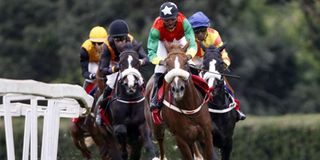Horse racing reflections as a new season begins

Jockeys in action during a past racing in Ngong.
I was tempted back to horse racing at the Ngong Road course when my friend Mauricio told me he runs a catering spot there these days. Last Sunday was the first race of the 2022/23 season. The sun was shining, I knew I could be back home for the Arsenal vs Liverpool match in the evening, and I fancied one of Mauricio’s Italian sausage sandwiches and a glass of his wine – so I went.
I was there when the gates opened at noon, in time for the first of seven races. I wasn’t expecting much of a crowd. The last time I was there was a Sunday in 2019, before Covid struck.
That day, there were very few spectators and no sense of occasion. It seemed the racing was in a sorry state of decline. The main reason I went then was to buy a copy of Shel Aransen’s And They’re Off – a very detailed history of racing in Kenya, full of excellent photographs.
Kenya has a rich history of horse racing. In the colonial days it was one of the favourite days out for the settler farmers, and it had two Lord Delameres as patrons. Then, in the years after independence, President Kenyatta occasionally attended and awarded key prizes.
In Shel Aransen’s book, there is a photo of Jomo Kenyatta, then as Prime Minister, congratulating Lady Diana Delamere (of White Mischief fame) after Sea Port won the first running of the Uhuru Cup in December 1963 – a cup donated by the Delameres.
But when I went to the races in the 1980s and ’90s, the grandstand was full of spectators and the horses were many. Along with the Tote betting agency, there was a line of bookmakers chalking up the odds. True, most of the owners were Europeans, together with a few Indians. Many of the spectators were also Europeans – as were a number of the jockeys.
Clearly, there is still a problem. The spectators last Sunday must have been less than a quarter of the crowd that attended the Concours d’Elegance held three weeks ago. There were only four runners in the big race, the Kenyatta Cup. OK, lots of Kenyans own cars; very few own horses. Cars mean something to Kenyans in a way that horses don’t.
But there is more to it than that. In all the years that I have attended the Concours, and when I have driven away when the prize giving was over, there were still many, many people arriving – young Kenyans looking forward to the music and the dancing. Also, apart from the core judging of the competing cars, there is the auto expo, the sale of classic cars, the children’s play area and lots of food and drinks stations. The Concours has become a very popular occasion.
After my modest and failed flutter on the Kenyatta Cup race, where I bet on Pat See, who came second to Dusha, I had a good chat with Kabir Dhanji, whose Kivuli Creative company has a contract for advising on how the Sunday races – every other Sunday through the season – could be revamped. He talked of three main strategies: attracting serious sponsors, promoting post-race parties, and encouraging spectators to dress-up for the event.
It seems the changed policy is already working. At the last meeting before the pre-Covid break, there were only about 90 spectators; last Sunday I reckon there must have been about 500. It was a very mixed 500 – reflecting the multi-cultural profile of Nairobi. And there were a few of them spicing the occasion with their dressing up.
There was a good and varied number of food stations. The old shelter that used to have the line of bookmakers is now a lively bar. And I enjoyed my glass of wine and Italian sausage at Mauricio’s.
The next race is next Sunday. Try it.





